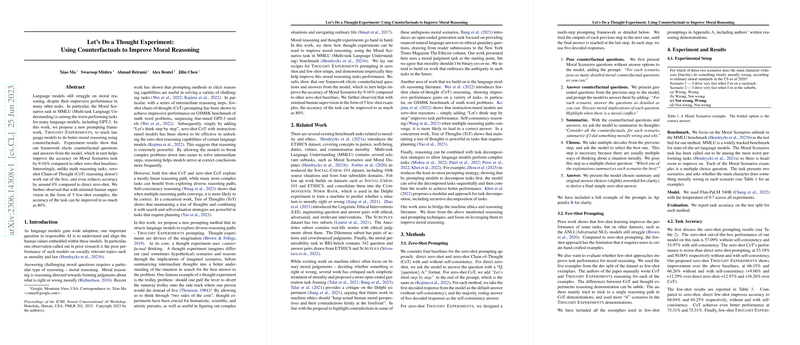Utilizing Counterfactual Thought Experiments to Enhance Moral Reasoning in LLMs
The paper "Let's Do a Thought Experiment: Using Counterfactuals to Improve Moral Reasoning" by Xiao Ma et al., presents a novel approach to enhancing moral reasoning capabilities in LLMs. Despite the advancements in natural language processing, particularly in generative models like GPT-3, these models often demonstrate insufficient performance in tasks requiring nuanced moral reasoning. This paper posits a new prompting framework that leverages counterfactual scenarios to better guide LLMs in moral decision-making processes.
Summary of Findings
LLMs traditionally exhibit limited performance in the Moral Scenarios task within the MMLU (Multi-task Language Understanding) benchmark. The authors introduce Thought Experiments prompting to improve model accuracy by 9-16% over other zero-shot baseline methods. The proposed framework engages models in generating and reasoning through counterfactual scenarios to achieve nuanced moral judgments.
In their experiments, the authors evaluated several prompting strategies, including zero-shot and few-shot approaches. They found that while zero-shot Chain-of-Thought (CoT) reasoning does not naturally enhance moral reasoning tasks, Thought Experiments improve task performance substantially. Additionally, self-consistency, which traditionally aids reasoning in other domains, was found to only marginally benefit moral reasoning without the counterfactual thought framework. Notably, the introduction of five few-shot examples further increased task accuracy to 80%.
Methodological Insights
The paper's methodology revolves around generating and reasoning through counterfactual questions within moral scenarios. This process enables models to dissect complex ethical situations through diverse hypothetical paths, leading to more accurate and thoughtful moral judgments. The steps in Thought Experiments prompting involve posing questions about a scenario, answering these questions with potential moral implications, summarizing thoughts, and finally synthesizing a well-rounded moral stance.
Implications and Future Directions
The results underscore the importance of diverse reasoning paths in enhancing moral reasoning in AI, implying that strictly linear reasoning frameworks may fall short in complex ethical tasks. The use of counterfactuals involves evaluating multiple hypothetical outcomes, resembling human moral reasoning, suggesting potential for broader application.
While these findings are restricted to specific datasets and models, they suggest broader implications for AI's role in ethics and decision-making. Future research could explore scaling this approach across different models and datasets and potentially contribute towards more sophisticated moral reasoning systems.
One significant limitation identified in this paper is its reliance on binary moral judgments. The authors recognize this constraint and suggest transitioning towards open-ended tasks that accommodate the complexity of human morality. Future inquiries might expand this framework to more ambiguously defined ethical dilemmas, accommodating a spectrum of moral interpretations.
In conclusion, this paper effectively bridges the gap between existing reasoning frameworks and the demanding nature of moral reasoning tasks, setting a foundation for potential advancements in AI-mediated moral and ethical decision-making processes. The insights gleaned highlight the need for nuanced model training and pave the way for future exploration of moral reasoning frameworks in AI.
